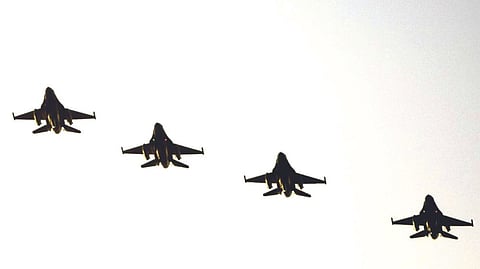

By David French
NEW YORK: The White House would no longer block its European allies from supplying Ukraine with American-made F-16 fighters. The move should greatly enhance Ukrainian military capabilities without significantly increasing the risk of unacceptable escalation in its conflict with Russia. (The decision still needs to be approved by some congressional leaders.)
The move came after a diplomatic blitz from Ukraine’s president, Volodymyr Zelensky, before this weekend’s Group of 7 summit in Hiroshima, Japan.
European leaders had signalled a willingness to supply F-16s from their own stocks and train Ukrainian pilots in their use. But until now, the Biden administration had nixed the idea. The reversal is a major, and welcome, policy change.
I came to Ukraine already believing that Kyiv needed advanced fighters, but I was unsure whether it needed F-16s specifically.
After all, European militaries also feature hundreds of European-designed and -manufactured generation 4.5 fighter aircraft.
To understand the critical importance of Ukraine’s request — and the rightness of the Biden administration’s decision — some basic background is necessary.
The jet fighter age is described in generations, which are categories of aircraft defined by their capabilities.
There’s some disagreement as to how to classify different aircraft, but as a general matter, the first three generations, running from the debut of jet fighters to the middle of the Cold War, are completely obsolete and are not part of the debate.
Fourth-generation planes, like early models of the F-15 and F-16 and the Russian MIG-29 and Su-27, were the best planes of the Cold War and are still in service in most modern militaries, including Russia’s and Ukraine’s.
The apex of current fighter technology is fifth-generation stealth fighters, which include the American F-22 Raptor and F-35 Lightning II and Russia’s Su-57.
Generation 4.5 is sandwiched between generations four and five: The fighters aren’t stealthy, but they have vastly upgraded avionics compared with fourth-generation fighters, and they can deploy more highly advanced armaments.
Generation 4.5 fighters include upgraded models of the American F-15, F-16 and F-18, as well as the Eurofighter Typhoon, Sweden’s Saab JAS-39 Gripen and France’s Dassault Rafale.
Crucially, the list also includes the Russian Su-30, Su-34 and Su-35. Russia has hundreds of generation 4.5 fighters. Ukraine has none. Instead it has a few dozen Soviet-era fourth-generation fighters.
Russia’s Su-35 (to take a key example) can hit targets at a range more than five times as great as Ukraine’s MIG-29 can. Moreover, such 4.5-generation fighters can carry a much greater array of advanced missiles than can Ukraine’s older fighters.
This means that Ukrainian planes have a more limited capacity to provide air defense within the country and no ability to create air superiority at or near the zero line, the very edge of the battlefront.
What does this mean as a practical matter? While I have firsthand knowledge that Western-supplied ground-to-air missiles (most notably, American Patriot missiles) can be remarkably effective against even Russian hypersonic missiles, at best, they can defend only small, confined areas of Ukraine. Vast areas of the front and most of Ukraine’s civilians and civilian infrastructure remain unacceptably vulnerable to Russian air attack.
Not only can F-16s fly the length and breadth of Ukraine to offer enhanced air defense; they also have a much greater capacity to strike Russian forces directly at the front and miles beyond.
Visit news.dtnext.in to explore our interactive epaper!
Download the DT Next app for more exciting features!
Click here for iOS
Click here for Android